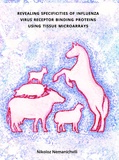Revealing specificities of influenza virus receptor binding proteins using tissue microarrays
Summary
The binding of a viral pathogen to the host cell is the first, crucial, step of infection. This first step in host-pathogen interactions is dependent on the attachment tools of the viral pathogen and the presentation of attachment factors by the host. Pathogen receptor specificity and host receptor distribution govern which cells and tissues are susceptible, known as host tropism. Using our own developed tissue microarrays to represent the host and the viral attachment proteins to represent the pathogen, we set out to study how receptor-binding interactions can improve our understanding of receptor distribution of both domestic and wild animals and how glycobiology plays a key role in driving these receptor-binding interactions. We used these tools to study and map the receptor binding of influenza A & D attachment proteins in respiratory tissues of various domesticated and wild animals. Receptor binding is the first step in infection and it is therefore of high importance to study it. The use of tissue microarrays is a great in-between system for studying the distribution of these host receptors. The system does have its shortcomings, particularly in terms of glycolipid and mucin detection. To summarize, TMAs are not a replacement for current methods used, such as glycan arrays and animal experiments, but are an excellent addition that complements those systems for studying receptor interactions.
